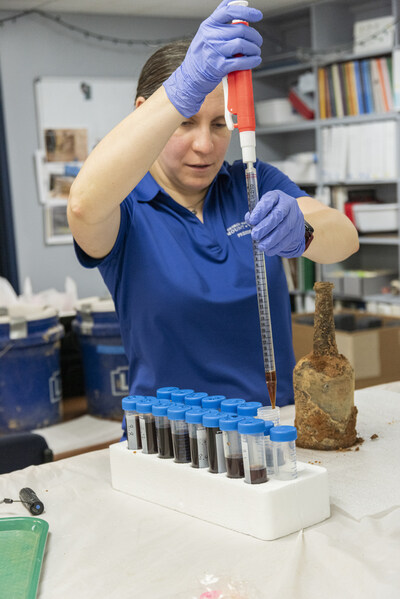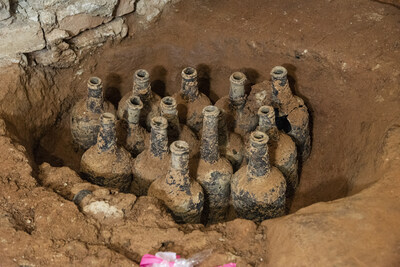Excavation Represents an Unprecedented Discovery of Pre-Revolutionary War Artifacts and Biological Matter
MOUNT VERNON, Va., June 13, 2024 /PRNewswire/ -- Archaeologists at George Washington's Mount Vernon have unearthed an astounding 35 glass bottles from the 18th century in five storage pits in the Mansion cellar of the nation's first president. Of the 35 bottles, 29 are intact and contain perfectly preserved cherries and berries, likely gooseberries or currants. The contents of each bottle have been carefully extracted, are under refrigeration at Mount Vernon, and will undergo scientific analysis. The bottles are slowly drying in the Mount Vernon archaeology lab and will be sent off-site for conservation.




This discovery follows a recent find in the cellar of two intact European-manufactured 18th-century glass bottles containing liquid, cherries, and pits. These archaeological finds are part of the landmark privately funded $40 million Mansion Revitalization Project at George Washington's Mount Vernon.
Photographs and video footage of the bottles' discovery at Mount Vernon are available here and should be attributed to the Mount Vernon Ladies' Association (MVLA).
"Never in our wildest dreams did we imagine this spectacular archaeological discovery," said Mount Vernon President & CEO Doug Bradburn. "We were ecstatic last month to uncover two fully intact 18th-century bottles containing biological matter. Now we know those bottles were just the beginning of this blockbuster discovery. To our knowledge, this is an unprecedented find and nothing of this scale and significance has ever been excavated in North America. We now possess a bounty of artifacts and matter to analyze that may provide a powerful glimpse into the origins of our nation, and we are crossing our fingers that the cherry pits discovered will be viable for future germination. It's so appropriate that these bottles have been unearthed shortly before the 250th anniversary of the United States," Bradburn said.
"These artifacts likely haven't seen the light of day since before the American Revolution, perhaps forgotten when George Washington departed Mount Vernon to take command of the Continental Army. This means the bottles are extremely fragile and require the utmost care. The Mount Vernon Ladies' Association was America's first historic preservation organization, so it's only fitting that such a remarkable discovery was made here at Mount Vernon. We are fortunate to have top archaeologists and historic preservation experts on staff who know how to effectively manage, analyze, and care for this extraordinary discovery.
"This historic discovery comes at the beginning of our transformational $40 million Mansion Revitalization Project to strengthen and restore the home of the nation's first president so that it will be stronger than ever when we celebrate America's 250th birthday in 2026. This historic preservation project is Mount Vernon's birthday gift to America," Bradburn added.
Mount Vernon Principal Archaeologist Jason Boroughs said, "These extraordinary discoveries continue to astonish us. These perfectly preserved fruits picked and prepared more than 250 years ago provide an incredibly rare opportunity to contribute to our knowledge of the 18th-century environment, plantation foodways, and the origins of American cuisine. The bottles and contents are a testament to the knowledge and skill of the enslaved people who managed the food preparations from tree to table, including Doll, the cook brought to Mount Vernon by Martha Washington in 1759 and charged with oversight of the estate's kitchen."
Mount Vernon has partnered with the United States Department of Agriculture's Agricultural Research Service (ARS) to analyze the contents of these historic bottles, composed of materials and foodstuffs that are likely 250 years old. While only a small quantity of the samples have been analyzed to date, the findings are significant even at this early stage:
- 54 cherry pits and 23 stems have been identified thus far, suggesting that the bottles were likely full of cherries before bottling. Cherry pulp is also present.
- Microscopy suggests that the cherries may have been harvested by snipping from trees with shears. The stems were neatly cut and purposefully left attached to the fruit before bottling.
- The cherries likely are of a tart variety, which has a more acidic composition that may have aided in preservation.
- The cherries are likely candidates for DNA extraction, which could be compared against a database of heirloom varieties to determine the precise species.
- The pits are undergoing an examination to determine if any are viable for germination.
The Mansion Revitalization Project is underway because today's highly popular Mansion performs functions it was not designed for. Built as a private residence, it is now a public monument visited by thousands daily, translating to a much heavier traffic flow than the Washingtons could have imagined. That increased visitation causes wear, tear, and strain on the building fabric. Although repairs throughout the Mansion's 290-year history have been accomplished using the best techniques available at the time, some of those repairs are now more than a century old. Significant advances in preservation technology afford exciting opportunities to improve structural and environmental conditions in the building, preparing it for another century of service.
Some of the earliest interventions completed in the Mansion were "localized" repairs intended to solve specific problems of immediate concern. Though successful, such repairs can have unintended consequences that affect the overall health of the Mansion. With this project, Mount Vernon's preservation team is proceeding holistically, approaching the Mansion as a complex network of interlocking systems. The primary tasks of the Mansion Revitalization Project include:
- Repairing sections of the Mansion's framing and masonry
- Installing a new heating/ventilation/air conditioning system
- Improving drainage in and around the Mansion's cellar
- Conducting research in rarely accessible spaces
When the Mount Vernon Ladies' Association took possession of George Washington's home in 1860, it faced a monumental restoration challenge. Since then, the MVLA has meticulously restored the Mansion and surrounding outbuildings, turning Mount Vernon into a shining example of historic preservation. After extensive investigation, assessment, research, planning, and design, Mount Vernon is taking proactive steps to ensure the health of the Mansion as it enters its fourth century. The Mansion Revitalization Project is being conducted in four phases and is scheduled for completion in 2026.
Mount Vernon, the home of George Washington, is owned and operated by the Mount Vernon Ladies' Association, the oldest national historic preservation organization in the United States. The estate is open to visitors and includes the Mansion, a museum and education center, gardens, tombs, a working farm, a functioning distillery, and a gristmill. It also includes the George Washington Presidential Library at Mount Vernon.
SOURCE George Washington's Mount Vernon

WANT YOUR COMPANY'S NEWS FEATURED ON PRNEWSWIRE.COM?
Newsrooms &
Influencers
Digital Media
Outlets
Journalists
Opted In






Share this article